|
Toyota Camry
Debut: 2006
Maker: Toyota
Predecessor: Camry (2001)
|
|
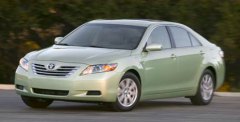 Undoubtedly,
Camry is very important to Toyota. On the one hand, itself was
the USA's best selling car for 8 times in the past 9 years (1997-2000
and 2002-2005), capturing 400,000 units or so sales every year. On the
other hand, it provides platform to other models like Avalon, Solara,
Lexus ES and Lexus RX. They form one of the 4 global core platforms for
Toyota - the others are the Corolla platform, Vitz / Yaris platform and
SUV / pickup platform. One can see how important it is. Undoubtedly,
Camry is very important to Toyota. On the one hand, itself was
the USA's best selling car for 8 times in the past 9 years (1997-2000
and 2002-2005), capturing 400,000 units or so sales every year. On the
other hand, it provides platform to other models like Avalon, Solara,
Lexus ES and Lexus RX. They form one of the 4 global core platforms for
Toyota - the others are the Corolla platform, Vitz / Yaris platform and
SUV / pickup platform. One can see how important it is.
To most people in the world, Camry is regarded to be oversize. Its
size, weight and engine capacity all point to executive class, yet it
does not have the sophistication and technology of an executive sedan.
This is because Toyota deliberately designed it for the North American
market as a family car for ordinary people. It must be spacious. It
must be torquey. It must be cheap. To realize these goals, Toyota
builds the Camry in its Kentucky plant using highly commonized parts,
such as the 3.5-litre DOHC VVT-i V6 and 2.4-litre DOHC VVT-i
inline-four. They have been appeared in so many Toyota and Lexus
models. The approach is similar to Carlos Ghosn's Nissan - higher
commonization means higher purchasing volume, hence lower purchasing
price for parts.
Another way to save cost is to sacrifice engineering excellence. While
most European and Japanese family cars have given up MacPherson struts
for rear suspensions in the attempt to improve ride and handling, Camry
still employ this compromised design at each corners. Yes, modern
damper technology, improved chassis rigidity and mounting methods can
still bring notable improvement to ride and handling, as you can see in
the new Camry, but other car makers are benefited by the same
advancement too. As I stressed many times in the reports for the last
Camry and its sister cars, all-strut suspensions is the biggest single
weakness of this platform. It led to the fact that Camry and co cannot
match other rivals in handling test.
 Toyota
also realized this, otherwise it would not have developed an SE version
for Camry. You may call it the "sport" version. It has stiffer springs
and shocks, thicker anti-roll bars, firmer bushings, extra bracing to
reinforce the rear bulkhead and all-round spoilers that was described
as "developed using Toyota's F1 technology". Well, forget the last
statement, as it is the pure imagination from their marketing people.
The Camry SE does feel much sportier than the past. The problem is, the
rest of the world is progressing at a faster pace still. A few years
ago no one would believe a front-drive family sedan can deliver poise,
grip and neutrality as good as sports cars. Now we have Peugeot 407. No
one would believe the vast improvement from Mazda 626 to Mazda 6.
Coincidence or not, both Peugeot 407 and Mazda 6 had switched to
double-wishbones front suspensions and multi-link rear suspensions. In
contrast, the Camry still relies on struts. Toyota
also realized this, otherwise it would not have developed an SE version
for Camry. You may call it the "sport" version. It has stiffer springs
and shocks, thicker anti-roll bars, firmer bushings, extra bracing to
reinforce the rear bulkhead and all-round spoilers that was described
as "developed using Toyota's F1 technology". Well, forget the last
statement, as it is the pure imagination from their marketing people.
The Camry SE does feel much sportier than the past. The problem is, the
rest of the world is progressing at a faster pace still. A few years
ago no one would believe a front-drive family sedan can deliver poise,
grip and neutrality as good as sports cars. Now we have Peugeot 407. No
one would believe the vast improvement from Mazda 626 to Mazda 6.
Coincidence or not, both Peugeot 407 and Mazda 6 had switched to
double-wishbones front suspensions and multi-link rear suspensions. In
contrast, the Camry still relies on struts.
So, despite of the introduction of SE version, no one would call the
Camry
a driver's car. If you push it into twisty roads, you will find it does
not have enough body control to inspire confidence. Its steering is
light, numb and uncommunicative. Try to push it into corners, its
stability control and traction control cut in early, hiding its limited
ability. Apparently, Toyota wants this car to be safe and predictable
rather than fun to drive.
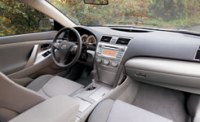 On the
positive side, the Camry is refined and well-built, thanks to Toyota's
trademark quality. Its engines are smooth, sound insulation is
remarkable and the suspensions work well to absorb bumps. The cabin is
made of good quality materials and the whole environment is enjoyable.
Space remains the same as before, but no one would complain it short of
space. Toyota knows very well what American wants - comfortable,
spacious, easy to drive and run. In this view, Camry suits them very
much. On the
positive side, the Camry is refined and well-built, thanks to Toyota's
trademark quality. Its engines are smooth, sound insulation is
remarkable and the suspensions work well to absorb bumps. The cabin is
made of good quality materials and the whole environment is enjoyable.
Space remains the same as before, but no one would complain it short of
space. Toyota knows very well what American wants - comfortable,
spacious, easy to drive and run. In this view, Camry suits them very
much.
Another requirement from the American is power. As before, the Camry
offers only a 4-pot engine and a V6 - few choices by European
norm. The balance-shafted 2.4-litre 16V VVT-i is modified from the old
generation. As improvement concentrated on reduction of NVH, power and
torque remain almost unchanged at 158 hp and 161 lbft respectively.
This is a decent entry-level engine, and is traditionally the better
selling engine in Camry. However, the 3.5-litre VVT-i V6 is even
better. Very powerful (268hp) and torquey (248lbft), the V6 mates with
a seamless 6-speed automatic transmission to deliver 0-60 mph in 6.7
seconds. It is a perfect engine to the power-hungry American, but the
fuel consumption and unfavourable tax category mean it won't be offered
in many countries, including Japan.
The Camry works very much like its exterior design suggests: refined,
well-built and easy going, but neither exciting nor unforgettable.
While it appeals to the American public, its success in Japan and
Europe will be limited. |
| The
above report was last updated on 18 May
2006. All Rights Reserved. |
Camry Hybrid
|
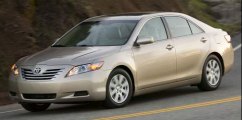 The
hybrid version of Camry combines the 2.4-litre four-pot engine with an
electric motor and CVT transmission to save fuel. The engine produces
147 horsepower, some 11 horses less than the standard Camry engine
because it employs “Atkinson combustion cycle” (see below) to enhance
frugality. The electric motor produces 45 horsepower and a useful 199
lbft of torque at very low rpm. They combine to 192 horsepower and a
particularly strong torque curve at low rev. The latter is reflected at
stop watch: despite of a hefty kerb weight of 1650 kilograms, Car and
Driver found it took 7.7 seconds to accelerate from 0-60 mph. Top
speed, however, is regulated to 117 mph. The
hybrid version of Camry combines the 2.4-litre four-pot engine with an
electric motor and CVT transmission to save fuel. The engine produces
147 horsepower, some 11 horses less than the standard Camry engine
because it employs “Atkinson combustion cycle” (see below) to enhance
frugality. The electric motor produces 45 horsepower and a useful 199
lbft of torque at very low rpm. They combine to 192 horsepower and a
particularly strong torque curve at low rev. The latter is reflected at
stop watch: despite of a hefty kerb weight of 1650 kilograms, Car and
Driver found it took 7.7 seconds to accelerate from 0-60 mph. Top
speed, however, is regulated to 117 mph.
In terms of performance, the Camry Hybrid is positioned midway between
the 2.4-litre and 3.5-litre Camry. However, it costs more than both
cars - 50% and 10% respectively. Buyers must
also prepare to sacrifice about 110 litres of luggage space, which is
eaten up by the Nickel-Metal-Hydride battery pack. In return, you get a
remarkable EPA fuel consumption rating at 43mpg for city and 37mpg for
highway.
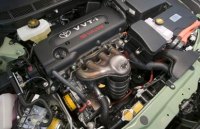 As usual,
the EPA figures are more optimistic than reality. Road & Track
recorded an average 37.3 mpg in its mixed-mode travel (C&D measured
33mpg), compared to the V6’s 26.3 mpg. At current fuel price it will
take 100,000 miles to return the price premium. And then you have to
consider its slower performance. As usual,
the EPA figures are more optimistic than reality. Road & Track
recorded an average 37.3 mpg in its mixed-mode travel (C&D measured
33mpg), compared to the V6’s 26.3 mpg. At current fuel price it will
take 100,000 miles to return the price premium. And then you have to
consider its slower performance.
Few magazines talk about the handling of hybrid cars. Admittedly, they
are designed to save fuel rather than to deliver driving excitement.
But I suppose when a hybrid car is good for 0-60 in seven point
something seconds, sometimes its driver may wish to attack corners. The
Camry Hybrid carries 160 kg more than the 2.4-litre Camry it based on
yet without the SE sports suspensions. The drawback is evident on
B-roads, where it feels bulky to handle.
High purchasing price, smaller luggage space and poorer handling are
what customers should consider before buying the Camry Hybrid. On the
plus side, help saving the earth shouldn’t be a bad idea.
Remark: Atkinson cycle
is
the naturally aspirated version of Miller cycle which was used in the
late Mazda Millenium / Eunos 800. In an Atkinson cycle engine, the
expansion stroke is longer than the compression stroke in order to
capture more energy which would otherwise lost in the form of exhaust
heat. To do this, Atkinson cycle engine has its intake valves remain
open during the initial phase of compression stroke. As a result, part
of the air escape back to the intake manifolds, reduces the effective
compression stroke and effective displacement of the engine.
|
| The
above report was last updated on 18 May
2006. All Rights Reserved. |
Camry Solara
|
 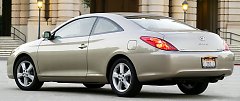
Solara
is the coupe version of Camry. Being built exclusively in Kentucky of
USA
alongside the Camry, it differs from the sedan by just packaging and
tuning.
It was styled by Toyota's California studio, hence looking sexier than
the Japanese-designed Camry. Nevertheless, there is strong traces of
Pininfarina's
Alfa GTV in its side profile, harming its originality. Besides, the
sedan
proportion (long wheelbase, long tail) doesn't do it justice. It should
have been more sporty, but sadly, Toyota would rather save money and
time
by building it directly on the Camry floorpan.
 So,
what you can expect from the Solara is spacious cabin, good build
quality
and remarkable comfort, just like the Carmy. It is powered by a new
3.3-litre
V6 from Lexus RX330. 225 horsepower might be a little underpowered by
today's
standard, but it remains smooth and quiet in Toyota's tradition.
Because
this is a comfort-biased coupe, the V6 can partner with only a 5-speed
automatic from the sedan, although ratios have been tightened to
improve
acceleration. It can therefore go from rest to 60mph in a brisk 7.0
seconds.
A drag coefficient of 0.29 also allows it to slip easily into air
stream. So,
what you can expect from the Solara is spacious cabin, good build
quality
and remarkable comfort, just like the Carmy. It is powered by a new
3.3-litre
V6 from Lexus RX330. 225 horsepower might be a little underpowered by
today's
standard, but it remains smooth and quiet in Toyota's tradition.
Because
this is a comfort-biased coupe, the V6 can partner with only a 5-speed
automatic from the sedan, although ratios have been tightened to
improve
acceleration. It can therefore go from rest to 60mph in a brisk 7.0
seconds.
A drag coefficient of 0.29 also allows it to slip easily into air
stream.
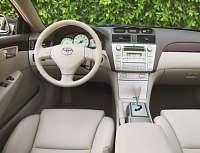 Enter
the cabin, after disappointed with the sedan-like dashboard design, you
will start appreciating the good materials and fit and finish as well
as
vast of space. Only taller passengers at the back will find their heads
toughing the fastback roof. Sound insulation is almost as effective as
the sedan. Enter
the cabin, after disappointed with the sedan-like dashboard design, you
will start appreciating the good materials and fit and finish as well
as
vast of space. Only taller passengers at the back will find their heads
toughing the fastback roof. Sound insulation is almost as effective as
the sedan.
Now fun
time....
maybe not
so fun. Although Toyota claimed to inject more sporting character into
the new Solara than the last generation, the scale of improvement is
actually
too small. It does have stiffer suspension setup than the sedan. It
does
employ a tower brace over the front suspension to stiffen the chassis.
It does have better sorted damping than the last generation. However,
compare
with European coupes it still cares too much about female buyers. With
relatively soft suspension setup and a bulky size, the Solara fails to
control roll and pitch as good as European coupes. This also leads to
severe
understeer at tight corners. Furthermore, the steering is too light and
too numb to give you any confidence. Some German cars are more capable
than inspiring. This Toyota is neither capable nor inspiring. It is
just
a sedan in a coupe's clothes. |
| The
above report was last updated on 26 Sep
2003. All Rights Reserved. |
|
|